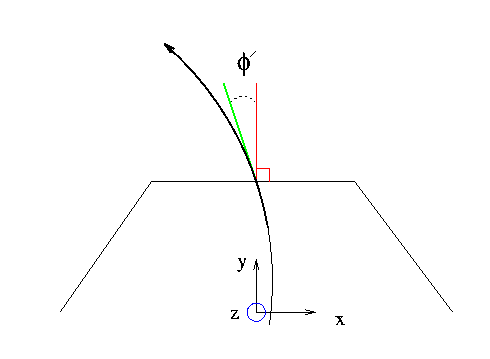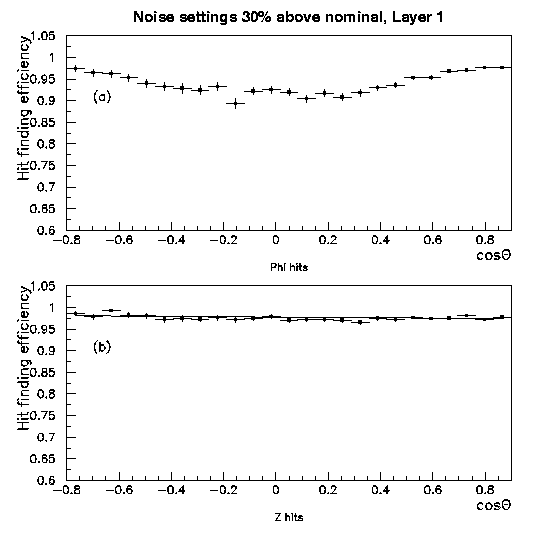-
The goal of this study is to see how the track finding efficiency is affected by various noise and background conditions. I've used release 6.6.2 with 5,000 generic B Bbar events generated in the same release, along with two background frames: a 1,000 event nominal background frame and 100 event 10 times nominal frame. To study how the efficiency is affected by noise, I've used both the nominal noise settings (see SvtElectronics/svteledata.dat in 6.6.2) and noise settings 30% higher than nominal (note that the thresholds were still kept at 4 x noise levels!).
-
SVT track finding efficiency is defined as
eff = (# of "perfect" reco tracks)/(# of SvtGTracks)
where SvtGTracks must satisfy a few conditions:
-
at least one geant hit in both the 1st and the 5th layers of silicon;
-
start in the beam pipe (rstart < 2.6cm);
-
be roughly within acceptance (-0.8 < cosTheta < 0.9);
and a "perfect" reco track is defined so that there is at most one mismatched (or missing) hit comparing to the hits on the corresponding geant track. It turns out that for nominal noise setings 98.9% of all reco tracks are "perfect" in this sense. This appears to be a feature of the current stand-alone SVT track finding algorithm
-
The table below summarizes SVT track finding efficiency for various noise and background conditions:
|
|
No Background |
No Background |
Nominal Background |
Nominal Background |
Background 10 x nominal |
Background 10 x nominal |
|
|
nominal noise settings |
noise and thresholds 30% above nominal |
nominal noise settings |
noise and thresholds 30% above nominal |
nominal noise settings |
noise and thresholds 30% above nominal |
|
Track Finding Efficiency |
(94.5 +- 0.3)% |
(85.7 +- 0.3(% |
(94.8 +- 0.5)% |
(84.9 +- 0.7)% |
(90.0 +-- 0.9)% |
(80.2 +-- 1.8)% |
There are a few conclusions here:
-
Track finding performance degrades by ~4% in the presence of background 10 times higher than nominal (with the reservation that this result is based on rather limited statistics)
-
Raising noise levels and thresholds by 30% leads to a very dramatic drop (~10%) of efficiency
-
SVT track finding efficiency as a function of transverse momentum (pt) and cosTheta for nominal noise settings and noise settings 30% higher than nominal (no background):
-
The track finding efficiency reaches its minimum for cosTheta ~ 0 tracks
-
The effect is particularly pronounced for noise settings 30% higher than nominal (the efficiency drops down to ~75%!)
-
It appears to be a reflection of hardware inefficiency: Phi hits are lost in the inner layers for cosTheta ~ 0 tracks
-
Hit finding efficiency is defined as (# of found SvtHits)/(# of SvtGHits). We are interested in its dependence on cosTheta and Phi', where Phi' is the azimuthal angle with respect to the perpendicular to the wafer:

-
Hit finding efficiency as a function of cosTheta for noise settings 30% higher than nominal:
 As expected, there is a dip in the Phi hit finding efficiency for cosTheta ~ 0.
As expected, there is a dip in the Phi hit finding efficiency for cosTheta ~ 0.
-
Hit finding efficiency as a function of Phi' for noise settings 30% higher than nominal:
-
A few conclusions here:
-
Hit finding efficiency drops down to ~75% for large Phi' for Phi strips in the inner layers, which is probably the result of smaller energy deposition per strip;
-
The effect is particularly pronounced for cosTheta ~ 0 tracks;
-
The effect is highly asymmetric (ExB);
-
The rapid drop of hit finding efficiency for large Phi' in the inner layers appears to be the major hardware inefficiency that we have to deal with. There are a few suggestions about what one can do to mitigate it:
-
One might consider using lower thresholds than 4 x noise for the Phi inner layers;
-
More specifically, one might want to use lower thresholds for the 3 chips on the right edge of the HDI than for all other chips;
-
Finally, it probably makes sense to tune the SVT track finding software at noise settings 30% higher than nominal.
|